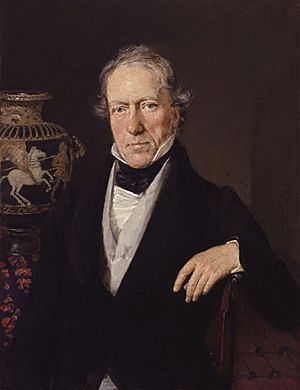William Martin Leake facts for kids
Quick facts for kids
William Martin Leake
|
|
|---|---|

William Martin Leake
portrayed by Christian Albrecht Jensen |
|
| Born | 14 January 1777 Mayfair, London |
| Died | 6 January 1860 (aged 82) Brighton |
| Title | FRS, DCL |
| Nationality | English |
William Martin Leake (14 January 1777 – 6 January 1860) was an English military man, topographer, diplomat, antiquarian, writer, and Fellow of the Royal Society. He served in the British military, spending much of his career in the Mediterranean seaports. He developed an interest in geography and culture of the regions visited, and authored a number of works, mainly about Greece.
Life
He was born in London to John Martin Leake and Mary Calvert Leake. After completing his education at the Royal Military Academy, Woolwich, he was commissioned a 2nd Lieutenant in the Royal Regiment of Artillery in 1794. Having spent four years in the West Indies as lieutenant of marine artillery, he was promoted to captain, and was sent in 1799 by the government to Constantinople to train the forces of the Ottoman Empire in the use of artillery. The British Empire had decided to support the Ottoman in its defence against Napoleonic France. A journey through Asia Minor in 1800 to join the British fleet at Cyprus inspired him with an interest in antiquarian topography. In 1801, after travelling across the desert with the Turkish army to Egypt, he was, on the expulsion of the French, employed in surveying the Nile valley as far as the cataracts; but having sailed with the ship engaged to convey the Elgin marbles from Athens to England, he lost all his maps and observations when the vessel foundered off Cerigo in Greece.
Shortly after his arrival in England he was sent out to survey the coast of Albania and the Morea, with the view of assisting the Turks against attacks of the French from Italy, and of this he took advantage to form a valuable collection of coins and inscriptions and to explore ancient sites. In 1807, war having broken out between Turkey and England, he was made prisoner at Salonica; but, obtaining his release the same year, he was sent on a diplomatic mission to Ali Pasha of Ioannina, whose confidence he completely won, and with whom he remained for more than a year as British representative.
In 1810 he was granted a yearly sum of £600 for his services in Turkey. In 1815 he retired from the army, in which he held the rank of colonel, devoting the remainder of his life to topographical and antiquarian studies. He was admitted a Fellow of the Royal Society on 13 April 1815.
He died in Steyning, Sussex on 6 January 1860. The marbles collected by him in Greece were presented to the British Museum; his bronzes, vases, gems and coins were purchased by the University of Cambridge after his death, and are now in the Fitzwilliam Museum. He was also elected a Fellow of the Royal Geographical Society, received the honorary DCL at Oxford (1816), and was a member of the Berlin Academy of Sciences and correspondent of the Institute of France.
Works
He authored:
- Researches in Greece (1814)
- The topography of Athens: With some remarks on its antiquities (1821)
- Journal of a tour in Asia Minor,: with comparative remarks on the ancient and modern geography of that country (1824)
- Travels in the Morea: With a map and plans (1830), and a supplement, Peloponnesiaca (1846)
- Travels in Northern Greece (1835)
- Numismata Hellenica (1854), followed by a supplement in 1859.
His Topography of Athens, the first attempt at a systematic treatment, long remained an authority.

